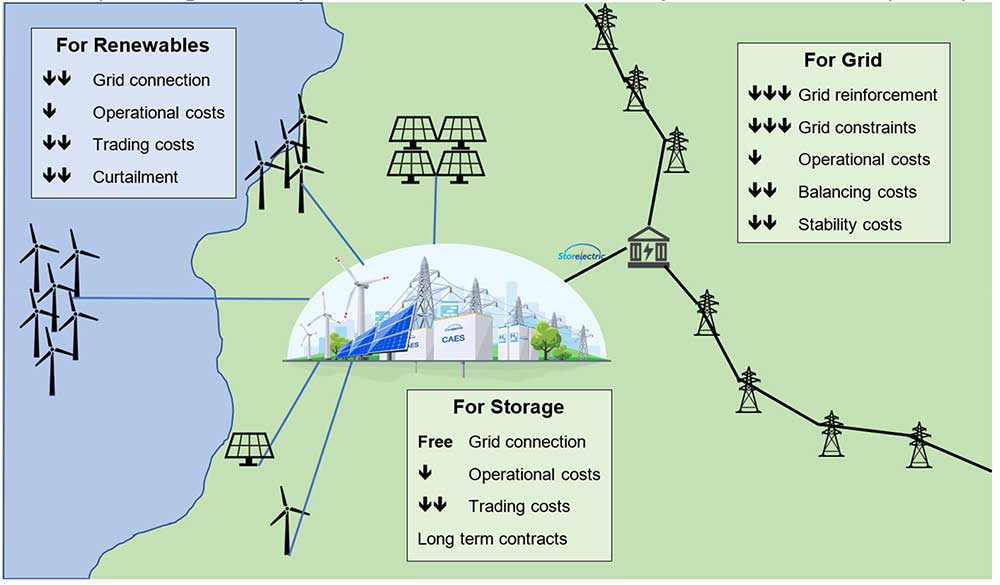Saving Billions on Grid Upgrades
In this post, we delve into cost-effective grid solutions and explore innovative approaches to address the rising challenges in grid reinforcement. Also, we cover the latest updates on onshore grid costs for new offshore wind projects in the UK.
Grid Costs for New Offshore Wind
In December 2021, Britain saw an increased need for onshore grid reinforcement to accommodate offshore wind generation. It required £20bn grid upgrades for just 8GW of new offshore wind. By that date, the total was 14GW operational + 8GW in construction. Onshore work had previously commenced. When adding reinforcements needed to connect up the balancing, stability, and operability services. This total is expected to be about £3bn per GW of new offshore wind. And that figure is rising fast, as the previous analyses show: in December 2020 the figure was £1.75bn per GW, and the Pathway to 2030 (June 2022) showed that to be increasing by 43% to 2040.
Operational Costs
Moreover, this incurs 10% additional on-costs every year thereafter (£300m p.a.) per GW, split roughly equally between maintenance and operational costs. And this ignores the contractual, emergency costs of procuring those balancing and stability services, or the ever-increasing complexity for the control centres to manage.
This is only about half of the enormous (and exponentially growing) non-energy costs of the energy system which were ~£8bn more in 2020-21 than just 3 years before, which split roughly:
- ¼ balancing services costs;
- ¼ stability, operability, ancillary, resilience and restoration services costs;
- ½ reinforcing the grid.
Note that the further the energy transition progresses, the higher the renewables penetration on the grid, and therefore the higher every one of these costs will rise – by ~43% for increased renewables 2030-2040, as calculated below.
Global Applicability
This analysis only focuses on the UK because the UK is further advanced than most in the decarbonisation of its grid (and most familiar to the author); the same issues will apply to most grids (e.g. the American ones) as they decarbonise. The cost of getting it wrong is immense: billions in capital costs, and over a billion in annual operational costs – as shown by the first UK Lockdown.
Cost effective grid solutions
Connecting large renewable generation to the grid through large-scale long-duration storage would greatly reduce costs and improve the services by:
- Reducing the size of grid connection and need for grid capacity / reinforcement – by a factor of 2-4 for offshore wind, 3-6 for onshore wind and 4-10 for solar;
- Providing the balancing services before the energy gets onto the grid, so that remote provision is not needed;
- Ditto stability services – all types of large-scale long-duration storage are naturally inertial, and Storelectric’s can produce double-scale inertia 24/7.
A 1GW output Storelectric Green CAESTM plant with 2GW input would save 1GW grid connection and reinforcement, totalling £3bn, at a cost of ~£1bn (first-of-a-kind ~£1.3bn), saving £2bn capital costs in addition to all its operational benefits (below).

Multi-Tasking, cost effective Technology
When evaluating various storage technologies, it’s crucial to assess their ability to deliver multiple services concurrently. This involves utilizing the same resources without dividing the plant’s output or storage capacity. For instance, a single large-scale, long-duration, naturally inertial plant can provide a diverse range of services simultaneously. This is akin to several batteries of the same size:
- Balancing services and arbitrage (based on power and duration);
- Ancillary services (based on speed of response);
- Inertial services (including related services, such as short-circuit levels) –
- Distinguish between real and synthetic inertia, the former being best for preventing failures and the latter for recovering from them, as shown here;
- Reactive power and load;
- Voltage and frequency regulation;
- Black start (without having to reserve capacity);
- Other services, e.g. constraint management, curtailment avoidance.
Integration with the Hydrogen Economy; an affordable grid solution
These cost effective grid solutions can be taken further. Intermittency is detrimental to electrolysis and related technologies like fuel/chemical synthesis and iron/steel making. It reduces efficiency and plant life. Additionally, it necessitates greater plant investment per unit output(and the technologies that use hydrogen, such as fuel/chemical synthesis, iron/steel making etc.) hate intermittency, which reduces efficiency and plant life while requiring much more plant investment per unit output. By taking out (most of? Storelectric can make plants much more efficient and cost-effective by addressing intermittency before it affects them, subject to cost/benefit analysis. The greater the integration, the better the synergies.

Steps to take towards an affordable grid solution
Government, regulator, and grid need to take several actions to enable this. Most of them cost little or nothing. If done fully and well, they achieve all benefits with purely commercial investment, without subsidy. This would save tens of billions in grid upgrade costs. It would further save billions in both operation/maintenance costs and procuring services. These services include balancing/constraints, inertia, and stability. As shown by the blackout on 8th August 2019. Also for energy sufficiency, black start, and other services. Additionally, it would make renewable generation cheaper and more profitable. These actions include:
- Provide a level regulatory playing field for storage, including a regulatory definition of storage as storage and not as a sub-set of generation;
- Make slight changes to the regulatory setting of OFTOs (which connect offshore wind to the grid), so that wind farms can benefit from the storage;
- Incentivise and support the construction of first-of-a-kind plants, which have for years been prevented by regulatory and contractual measures;
- Provide contracts with durations and breadth that enable large, flexible plant to compete with smaller and more narrowly capable ones.


